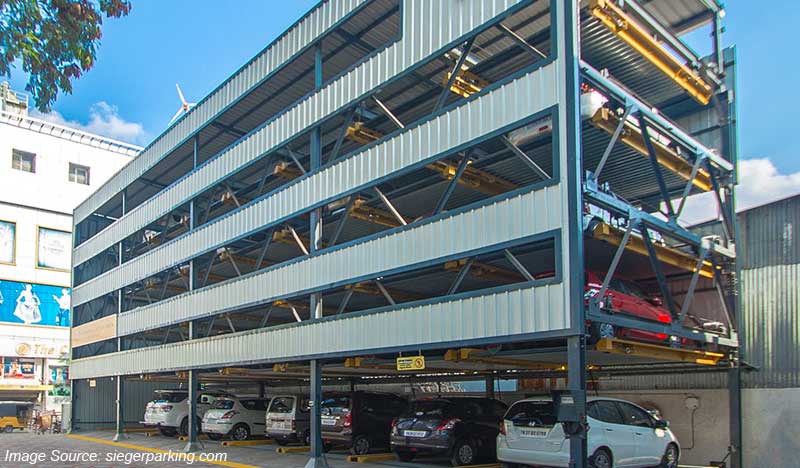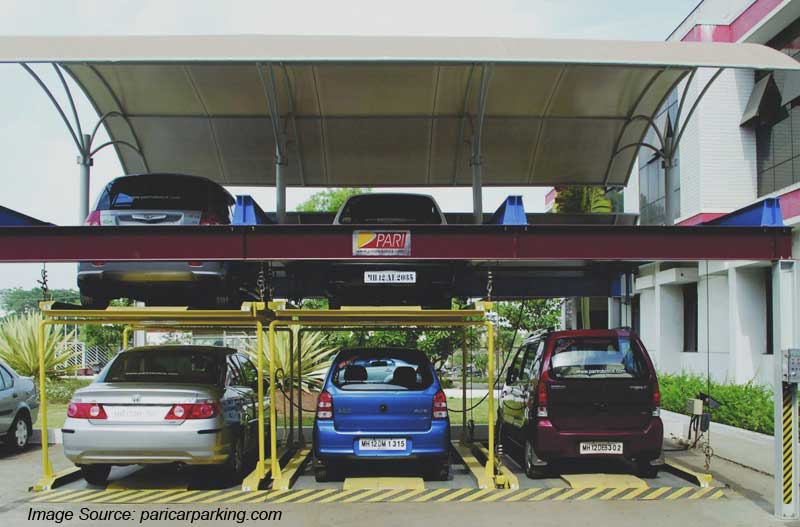Puzzle Parking System, a type of automated car parking is in recent trend now owing to the verdict of Maharashtra Real Estate Regulatory Authority (MahaRera). Automated parking systems are being implemented for the benefit of Builders, Car Owners and also for pedestrian safety. Builders can accommodate more cars in smaller footprints of the buildings and Car owners get a secured parking space and drivers and passengers do not have to maneuver through cramped parking garages with little space for pedestrians to walk. This could prevent car-pedestrian accidents from occurring. They also help save space.
Recent Case of Puzzle Car Parking System
Maharashtra Real Estate Regulatory Authority (MahaRera) has declared that puzzle parking is part of the common areas in a housing project. The order was passed on a complaint by Devarajan Swaminathan, a resident of Lodha Casa Royale at Balkum, Thane (West). The project comprises three towers of 432 flats with basement, stilt, open and puzzle parking.
In the last tower of 122 flats, 24 flat owners, including Swaminathan, were allotted puzzle parking by the developer. The society asked them to bear the expenses of its maintenance although they paid proportionate contribution towards other amenities like other members. Swaminathan sought clarification whether a puzzle car park is included in the common areas of the project.
He argued if there is a structural damage to a pallet, why should any one or few have to bear the expenses. In his December 11 order, MahaRera member B D Kapadnis observed that the puzzle car parking system features combination pallets carrying cars. “Individually, the load and unload of the cars is possible. Thus, it is an independent system which is electromechanically operated. Fast in and out of the cars is possible. Combination of multiple levels vertically and horizontally is possible. It is mostly preferred in residential complexes,” he added.
Kapadnis noted that under Rera, the definition of common areas means “the common basement, terrace, parks, play areas, open parking areas and common storage spaces”. A specific car parking (in a puzzle park setup) to the exclusion of others cannot be allotted to any one allottee and is not possible also. A car can be parked at any level and at any available space. After considering the concept of puzzled parking as explained above, I find that it is a common area and I declare it to be so,” said Kapadnis, disposing of the complaint.

There will be minor issues that need to be addressed as the movement from mechanical to automatic and semi-automatic car parking increases……………….
The evolution of the car parking system
The evolution of the car system has been smoothly done, from mechanized to automatic and semi-automatic systems it has gone through a change. Over the years, car parking systems and the accompanying technologies have increased and diversified. Car parking systems have been around almost since the time cars were invented. In any area where there is a significant amount of traffic, there are car parking systems. Car Parking systems were developed in the early 20th century in response to the need for storage space for vehicles. There are several advantages of employing a car park system for urban planners, business owners and vehicle drivers. They offer convenience for vehicle users and efficient usage of space for urban-based companies. Automated car park systems save time, money, space and simplify the often tedious task of parking. Auto car lifts move vehicles into safe and secure storage areas until they are needed.
Mechanical parking was highly useful at times. The parking system involved a mechanical device that multiplied parking capacity inside a parking lot. These parking systems are generally powered by electric motors or hydraulic pumps that move vehicles into a storage position. Then developed a stacker parking system, which involved a level lift for storing cars vertically. The stacker lifts vehicles on cantilevered platforms between shared common legs so that additional cars can be parked below.
Over the world, especially in the big cities, it’s really hard for drivers to find a parking place, thus the parking lots cannot give enough space to everyone’s cars. There is a need for an automatic and dimensional parking system, to help people to park their cars and improve people’s daily life. Therein developed, semi-automation and automation system.
The concept for the automated parking system was and is driven by two factors: a need for parking spaces and a scarcity of available land. The earliest use of an APS was in Paris, France in 1905 at the Garage Rue de Ponthieu. The APS consisted of a groundbreaking multi-story concrete structure with an internal elevator to transport cars to upper levels where attendants parked the cars. In the 1920s, a Ferris wheel-like APS (for cars rather than people) called a paternoster system became popular as it could park eight cars in the ground space normally used for parking two cars (Now it is called a Rotary Parking System). Mechanically simple with a small footprint, the paternoster was easy to use in many places, including inside buildings. At the same time, Kent Automatic Garages was installing APS with capacities exceeding 1,000 cars. The first driverless parking garage opened in 1951 in Washington, D.C., but was replaced with office space due to increasing land values.
Semi-Automatic and Automatic parking systems are structures where cars are stacked vertically to limit space. The designs of these unique systems help transport vehicles from the entrance to its parking space without the driver present. APS provides parking for cars on multiple levels stacked vertically to maximize the number of parking spaces while minimizing land usage. The APS, however, utilizes a mechanical system to transport cars to and from parking spaces (rather than the driver) to eliminate much of the space wasted in a multi-story parking garage.

Difference between a fully-automatic and a semi-automatic car parking system
The difference between a fully-automated APS and a semi-automated APS is whether or not it needs a parking attendant to drive or direct the cars into the machine. Fully-automated parking systems do not need an attendant, and the APS’s mechanical processes will transport vehicles from the start of the garage into an empty parking space.
Another differentiating factor between a fully and semi-automated APS is often space and cost. The areas with larger capacity, i.e. more than 100 cars, tend to be fully automated. Because of their comparatively smaller volume and mechanism, APS is mostly present in locations where a multi-story garage would be overly big, immoderately costly, or unrealistic.
Different types of car parking types fall under a fully-automatic and semi-automatic car parking system. We are focusing on the Puzzle Parking System.
Puzzle Parking System
Puzzle Parking is a Semi-automated system that features combination pallets that enable horizontal and vertical movement of parking spots just like a puzzle to park and retrieve cars. It is an independent parking system, unlike Stacker Parking, there is no dependency of any car on other cars for retrieval from the system, it can be easily configured and customized to any property criteria. The system comes with a mechanical device that multiplies parking capacity inside a parking lot. Parking systems are generally powered by electric motors or hydraulic pumps that move vehicles into a storage position.

How does the puzzle parking system work?
If the Empty Platform is available on Ground/Driveway Level, the driver leaves the car on the platform, the platform is designed in such a way that the driver needs to drive the car till the front wheel stopper, Once the same is done, the driver comes out and confirms the parking completion on the operator panel, If there is an in-line command exists for parking or retrieval of cars in same system, the system takes the platform to its resting position (parking position) and brings the next platform down for next operation. The Motors with Chain sprockets or Hydraulic Cylinders help in lifting or lowering the platform from parking positions to retrieving (Ground/Driveway) level. The Platforms are moved vertically or Horizontally to retrieve the required platform from the system. When the vehicle is needed, the process is reversed and the car lifts transport the vehicle back to the same area where the driver left it.
Puzzle parking system advantages
- Multiple entries to reduce time
- Added Yellow Pipe Barrier on Platform for height restriction
- Easy maintenance
- Low operating costs
- The variation available from 2 to 7 levels
- Photo – Electric Sensor for safety
- Safety Locks
- Anti – Corrosive Platforms
- Anti – Slip Platform Design
- PLC based system for better control and smooth operation sequencing.
- Touch Screen operation with Fault/Error Display (With location of Error)
Puzzle Car Parking systems are suitable for outdoor parking, where the cars on the floor level are parked manually and the rest of the floors are parked automatically. It is best suited for residential complexes, IT Parks commercial complexes, malls and hotels.
The rise in the demand for semi-automatic, fully-automatic and sustainable parking solutions is a driving factor for the growth of the automated parking system market. The increase in urbanization will also accelerate the automated parking systems market. The availability of fewer parking spaces for the automobile is the driving factor for the growth of the automated parking systems market. The rise in automation and ADAS systems will also contribute to the growth of the automated parking systems market.

